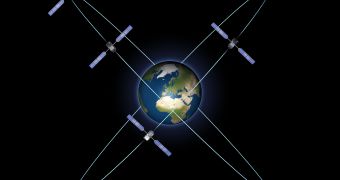A few years ago, the European Union mandated the European Space Agency (ESA) to start working on a satellite navigation and positioning system, called Galileo. In 2011 and 2012, the first four Galileo test satellites were launched, and recently ESA has confirmed that the network is functional and can be expanded.
When completed, Galileo will become the first satnav system in the world to be the fully owned and operated by a civilian entity. The US Global Positioning System (GPS), which was until now the only provider of satnav capabilities in the world, is owned and operated by the military.
The four In-Orbit Validation Phase (IOV) Galileo satellite constitute the operational nucleus of the European constellation, as well as the minimum number of spacecraft needed to produce a fix. The IOV procedure also included a growing global ground support infrastructure.
“IOV was required to demonstrate that the future performance that we want to meet when the system is deployed is effectively reachable. It was an intermediate step with a reduced part of the system to effectively give evidence that we are on track,” explains the ESA manager for Galileo's ground systems, Sylvain Loddo.
Galileo obtained its first-ever navigations fix on March 12, 2013. The event took place at the ESA European Space Research and Technology Center's (ESTEC) Navigation Laboratory, in Noordwijk, the Netherlands. Numerous other tests have followed since.
“ESA and our industrial partners had teams deployed in the field continuously for test operations. More than 10,000 km (6,200 mi) were driven by test vehicles in the process of picking up signals, along with pedestrian and fixed receiver testing. Many terabytes of IOV data were gathered in all,” says Marco Falcone, who is the Galileo System Manager at ESA.
Following this comprehensive suite of tests, Galileo has finally been proven to work extremely well. The system is now capable of providing accurate positioning fixes across the entire planet.
With just four satellites, the constellation is able to pinpoint distress signals with an accuracy of 2 kilometers (1.4 miles) in 77 percent of cases, and 5 kilometers (3 miles) in 95 percent of cases. As new satellites will be added, these figures will improve drastically, ESA estimates.
“Europe has proven with IOV that in terms of performance we are at a par with the best international systems of navigation in the world,” concludes the ESA Director of Galileo and Navigation-related Activities, Didier Faivre.

 14 DAY TRIAL //
14 DAY TRIAL //